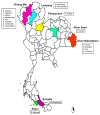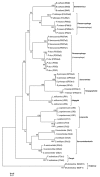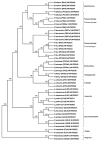Mitochondrial DNA-Based Identification of Forensically Important Flesh Flies (Diptera: Sarcophagidae) in Thailand
- PMID: 31861293
- PMCID: PMC7022518
- DOI: 10.3390/insects11010002
Mitochondrial DNA-Based Identification of Forensically Important Flesh Flies (Diptera: Sarcophagidae) in Thailand
Abstract
Flesh flies (Sarcophagidae) are necrophagous insects initially colonizing on a corpse. The species-specific developmental data of the flies collected from a death scene can be used to estimate the minimum postmortem interval (PMImin). Thus, the first crucial step is to correctly identify the fly species. Because of the high similarity among species of flesh flies, DNA-based identification is considered more favorable than morphology-based identification. In this study, we demonstrated the effectiveness of combined sequences (2216 to 2218 bp) of cytochrome c oxidase subunit I and II genes (COI and COII) for identification of the following 14 forensically important flesh fly species in Thailand: Boettcherisca nathani Lopes, Fengia ostindicae (Senior-White), Harpagophalla kempi (Senior-White), Liopygia ruficornis (Fabricius), Lioproctia pattoni (Senior-White), Lioproctia saprianovae (Pape & Bänziger), Parasarcophaga albiceps (Meigen), Parasarcophaga brevicornis (Ho), Parasarcophaga dux (Thomson), Parasarcophaga misera (Walker), Sarcorohdendorfia antilope (Böttcher), Sarcorohdendorfia inextricata (Walker), Sarcorohdendorfia seniorwhitei (Ho) and Seniorwhitea princeps (Wiedemann). Nucleotide variations of Thai flesh flies were evenly distributed throughout the COI-COII genes. Mean intra- and interspecific variations ranged from 0.00 to 0.96% and 5.22% to 12.31%, respectively. Using Best Match (BM) and Best Close Match (BCM) criteria, identification success for the combined genes was 100%, while the All Species Barcodes (ASB) criterion showed 76.74% success. Maximum Likelihood (ML) and Bayesian Inference (BI) phylogenetic analyses yielded similar tree topologies of monophyletic clades between species with very strong support values. The achieved sequences covering 14 forensically important flesh fly species including newly submitted sequences for B. nathani, F. ostindicae and S. seniorwhitei, can serve as a reliable reference database for further forensic entomological research in Thailand and in other areas where those species occur.
Keywords: COI; COII; Thailand; flesh flies; forensic entomology; molecular identification.
Conflict of interest statement
The authors declare no conflict of interest.
Figures



Similar articles
-
DNA-based characterisation and classification of forensically important flesh flies (Diptera: Sarcophagidae) in Malaysia.Forensic Sci Int. 2010 Jun 15;199(1-3):43-9. doi: 10.1016/j.forsciint.2010.02.034. Epub 2010 Apr 13. Forensic Sci Int. 2010. PMID: 20392577
-
Morphology of puparia of flesh flies in Thailand.Trop Biomed. 2014 Jun;31(2):351-61. Trop Biomed. 2014. PMID: 25134905
-
Identification of the forensically important sarcophagid flies Boerttcherisca peregrina, Parasarcophaga albiceps and Parasarcophaga dux (Diptera: Sarcophagidae) based on COII gene in China.Trop Biomed. 2010 Dec;27(3):451-60. Trop Biomed. 2010. PMID: 21399586
-
A brief review of forensically important flesh flies (Diptera: Sarcophagidae).Forensic Sci Res. 2018 Mar 22;3(1):16-26. doi: 10.1080/20961790.2018.1432099. eCollection 2018. Forensic Sci Res. 2018. PMID: 30483648 Free PMC article. Review.
-
Parasarcophaga (Liopygia) ruficornis (Diptera:Sarcophagidae): a flesh fly species of medical importance.Trop Biomed. 2013 Jun;30(2):174-80. Trop Biomed. 2013. PMID: 23959482 Review.
Cited by
-
Wohlfahrtia nuba (Wiedemann, 1830) (Diptera: Sarcophagidae) Development and Survival Under Fluctuating Temperatures.Insects. 2025 Jun 13;16(6):628. doi: 10.3390/insects16060628. Insects. 2025. PMID: 40559058 Free PMC article.
-
Geographical Distribution and Multimethod Species Identification of Forensically Important Necrophagous Flies on Hainan Island.Insects. 2023 Nov 20;14(11):898. doi: 10.3390/insects14110898. Insects. 2023. PMID: 37999097 Free PMC article.
-
Megaselia scalaris and Senotainia tricuspis Infesting Apis mellifera: Detection by Quantitative PCR, Genotyping, and Involvement in the Transmission of Microbial Pathogens.Insects. 2024 Oct 9;15(10):786. doi: 10.3390/insects15100786. Insects. 2024. PMID: 39452362 Free PMC article.
References
-
- Byrd J.H., Castner J.L. Insects of forensic importance. In: Byrd J.H., Castner J.L., editors. Forensic Entomology: The Utility of Arthropods in Legal Investigation. 2nd ed. CRC Press; Boca Raton, FL, USA: 2010. pp. 39–136.
-
- Sukontason K., Narongchai P., Kanchai C., Vichairat K., Sribanditmongkol P., Bhoopat T., Kurahashi H., Chockjamsai M., Piangjai S., Bunchu N., et al. Forensic entomology cases in Thailand: A review of cases from 2000 to 2006. Parasitol. Res. 2007;101:1417–1423. doi: 10.1007/s00436-007-0659-8. - DOI - PubMed
Grants and funding
LinkOut - more resources
Full Text Sources
Research Materials

